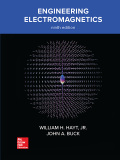
Concept explainers
Volume charge density is located as follows; pv=0 for p<1 mm and for p>2 mm, pv=4p đ�œ‡C/m3 for 1
(a)
Total charge in the given region.
Answer to Problem 3.15P
Explanation of Solution
Given Information:
Concept used:
Calculation:
Conclusion:
Total charge is
(b)
The value of
Answer to Problem 3.15P
Explanation of Solution
Given Information:
Concept used:
Gauss's law,
Calculation:
Conclusion:
(c)
The value of
Answer to Problem 3.15P
Explanation of Solution
Given Information:
Concept used:
Calculation:
At
So
At
At
is written as
Conclusion:
Want to see more full solutions like this?
Chapter 3 Solutions
Engineering Electromagnetics
- "Based on a source, book, or expertise in the specialized field, I need a solution to the question." Write an Arduino programming code that activates eight LEDs connected to pins 0 to 7 successively with an interval of 1 second when switch S₁ connected to pins 8 is turned ON, and all LEDs are activated when switch S₂ connected to pins 9 is turned off. (Hint: use array method).arrow_forwardDetermine X(w) for the given function shown in Figure (1) by applying the differentiation property of the Fourier Transform. 1 x(t) Figure (1) -1 1 2arrow_forward5. Determine an expression for vo as a function of vs in the circuit shown below. Assume the operational amplifier is ideal (10 pts) 162 + + 212 10052} -j 100-52 Noarrow_forward
- 4. A 120 volt rms voltage source supplies 20 Amps rms to a load. The load requires 2,078 watts. What is the reactive power (Vars) and the power factor of the load. Assume the load is inductive. (15pts)arrow_forward6. Determine the rms value of the voltage cyclical waveform shown below. (15 pts) Zv N 시 ما Msec 8arrow_forward7. If the power factor of a load is unity is this also the condition for maximum power transfer? Why or why not? (10 pts)arrow_forward
- Pls show neat and whole solutionarrow_forwardDraw a diagram for a UPS that takes in an input of 690Vac 3 phase and a output of 30kVA single phase.arrow_forwardCan you draw the computed panel board (2nd attached pic) like the panel board management (1st attached pic)? ps. not graded, i just want to know what it looks like when it draw.arrow_forward
- For the circuit shown, let Is = 5, R₁-40, R2-30, R3-100, R4-80, R5-40, R6-30, R7- 10, and Rg= 100, and find: R₂ R6 ww www VX R3 R7 R8 RI R₁₂ Rs R5 www • The voltage Vx" (V) ⚫ The power absorbed by the output resistor Rg: Power= {Hint: you can use current divider (CD) or any other method.} (W) Tarrow_forwardFor the circuit shown, let V₁ = 26, R1-30, R₂-40, R3-50, R4-20, R5-100, R6-10, and find: RA R5 R3 V (+) R₁ R₂ R6 www • The voltage v (V) • The power delivered by the power source Vs: Power= {Hint: you can use voltage divider (VD) or any other method.} (W)arrow_forwardIn the circuit shown, let R₁-7, R₂-12, R3-24, R4-2, V₁ =17, V2 -68, and V3-51, to calculate the power delivered (or absorbed) by the circuit inside the box, as follows: {NOTE: On Multiple Choice Questions, like this problem, you have only one attempt } 1. The current I is equal to (choose the closed values in amperes) -0.791 0 -0.756 3.022 0.756 (A) -3.022 0.791 2. The power delivered (or absorbed) (choose the closest value in watts) (W) 373.345 0 -373.345 -52.234 52.234 65.079 O-24.833 R₁ V₂ R3 R₂ www V3 V₁ www R4arrow_forward
 Introductory Circuit Analysis (13th Edition)Electrical EngineeringISBN:9780133923605Author:Robert L. BoylestadPublisher:PEARSON
Introductory Circuit Analysis (13th Edition)Electrical EngineeringISBN:9780133923605Author:Robert L. BoylestadPublisher:PEARSON Delmar's Standard Textbook Of ElectricityElectrical EngineeringISBN:9781337900348Author:Stephen L. HermanPublisher:Cengage Learning
Delmar's Standard Textbook Of ElectricityElectrical EngineeringISBN:9781337900348Author:Stephen L. HermanPublisher:Cengage Learning Programmable Logic ControllersElectrical EngineeringISBN:9780073373843Author:Frank D. PetruzellaPublisher:McGraw-Hill Education
Programmable Logic ControllersElectrical EngineeringISBN:9780073373843Author:Frank D. PetruzellaPublisher:McGraw-Hill Education Fundamentals of Electric CircuitsElectrical EngineeringISBN:9780078028229Author:Charles K Alexander, Matthew SadikuPublisher:McGraw-Hill Education
Fundamentals of Electric CircuitsElectrical EngineeringISBN:9780078028229Author:Charles K Alexander, Matthew SadikuPublisher:McGraw-Hill Education Electric Circuits. (11th Edition)Electrical EngineeringISBN:9780134746968Author:James W. Nilsson, Susan RiedelPublisher:PEARSON
Electric Circuits. (11th Edition)Electrical EngineeringISBN:9780134746968Author:James W. Nilsson, Susan RiedelPublisher:PEARSON Engineering ElectromagneticsElectrical EngineeringISBN:9780078028151Author:Hayt, William H. (william Hart), Jr, BUCK, John A.Publisher:Mcgraw-hill Education,
Engineering ElectromagneticsElectrical EngineeringISBN:9780078028151Author:Hayt, William H. (william Hart), Jr, BUCK, John A.Publisher:Mcgraw-hill Education,





